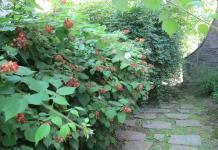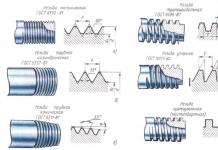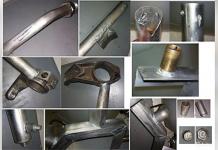The attic, which allows you to effectively use the floor area of a private house, is a rather complicated design. As a rule, homeowners entrust its construction to experienced craftsmen - roofers. But if you are a carpenter and are not afraid of difficulties, then you can certainly cope with the task yourself. The first step is to gain theoretical knowledge about how a mansard roof is calculated and built with your own hands according to individual drawings. You will find this information presented in the form of a step-by-step guide in this article.
The choice of roof design
For the device of the attic floor, instead of the usual attic, the following types of roofs are suitable (shown in the diagram below):
- ordinary gable with a slope of 45 ° or more (steep);
- broken roof;
- four-slope semi-hip.
Note. As can be seen from the diagram, various half-hip coverings are complicated gable roofs, so it makes no sense to consider them separately. In terms of design, the multi-gable design shown in the photo is of interest, but decent experience is needed to build it.

A gable mansard roof is the simplest in execution and economical in terms of material consumption. But you will have to pay for this with a smaller usable area and sloping walls of the attached floor, which do not allow you to place tall furniture. This will not be a problem if it is planned to equip a bedroom in the attic - the beds will calmly stand near the longitudinal walls. Another way to resolve the issue is to raise the truss system to the required height, as shown in the drawing below.

Roofing with broken shapes is the most popular option, since it allows you to make full-fledged living rooms upstairs. If protruding windows are not provided on its slopes, then according to the installation technology, such a roof is not much more complicated than a gable roof, although the consumption of building materials will increase. To simplify your choice, we propose to consider and compare the 3 most common options for an attic superstructure for a private house in standard sizes of 6 x 6 m:
- Steep roof with two pitches inclined at an angle of 45°.
- A broken structure, where the lower rafters are inclined at an angle of 60 °, and the upper - 30 °.
- Same as option 1, only the trusses are raised to a height of 60 cm, and the rafter legs are at an angle of 37.5 °.
For convenience, we have depicted all three structures in one drawing, which can be taken as a basis for future construction.

Note. A board with a cross section of 50 x 150 mm was taken as the main building material for the manufacture of rafters and other frame elements.
To choose the best of the three options, we propose to study the comparative table, which presents the parameters of the attic space based on 1 linear meter of the length of the building.

Knowing the length of the roof slopes indicated in the plate, you can roughly estimate the consumption of building materials for the frame, coating and insulation. The following table makes it possible to estimate the total area of the rooms on the second floor when implementing all 3 solutions in private houses with different sizes.

Calculation of the truss system
Do-it-yourself attic rafters must withstand the following loads during the entire period of operation:
- own weight;
- mass of roofing and insulation;
- maximum wind gusts for the area;
- snow cover pressure.
Reference. With a roof slope of more than 45 °, snow practically does not linger on it, and at 60 ° it is not taken into account at all in the calculations. But the wind pressure increases due to the height of the structure and its position close to vertical.

The result of the calculations should be 2 parameters - the cross section of the rafters with beams (otherwise - puffs) and the step of their installation. It is a mistake to think that the dimensions of the wooden beams of the roof grow along with the loads on it. The maximum rigidity of the structure is achieved through the use of roof trusses made of logs with a diameter of 120-200 mm or lumber with a thickness of 40 to 200 mm, installed in increments of 50-120 cm. If you are not a civil engineer, you will not be able to determine these values more precisely, since the technique pretty complicated.
Online calculators posted on the Internet do not solve the issue, because their calculations still need to be checked. The way out is this: use ready-made data that has been calculated for a long time. To do this, you will need table No. 1, which shows the sections of the rafter legs for various lengths and loads:

Let us explain the calculation method with an example. Suppose that the snow load on a flat surface (projection of a pitched roof) in your area is 100 kg / m², the slope is 60 °, the span is 4.5 m (to the strut), the rafter spacing is 120 cm. The roofing is slate. We believe:
- The actual weight of the snow cover: 100 x 0.32 = 32 kg / m². The slope factor of 0.32 is taken from Table 2 below.
- The specific weight of a slate coating with a conventional profile is 25 kg / m².
- The total specific gravity is 32 + 25 = 60 kg / m².
- We calculate the specific gravity per 1 linear meter of rafters by multiplying 60 kg / m² by an installation step of 1.2 m. We get 72 kg.
- We return to table No. 1 and select the cross section of the beam along the length of the span. We accept a load of 100 kg per 1 meter of rafters (with a margin). A log with a diameter of 140 mm, a board of 40 x 200 mm and other materials whose dimensions are in the same horizontal line are suitable.

Reference. When installing a broken mansard roof, 2 types of rafters are used - layered and hanging. On a gable roof, only hanging ones are used, what is the difference between them, is shown in the diagram.

The last table No. 3 will help you correctly determine the installation interval for truss trusses:

The proposed method is suitable for small rectangular houses with dimensions of 6 x 6 m. To build a mansard roof on a large cottage, it is strongly recommended to contact specialists - designers for calculations.
Frame manufacturing
The simplified method presented below involves the construction of a mansard sloping roof in 2 stages: assembly of roof trusses on the ground and subsequent installation on the finished walls of a timber or log house. The structural material is boards with a section of 15 x 5 and 10 x 5 cm with a standard length of 6 m.

The beginning of the assembly - the formation of the upper belt of the truss system
Step by step technology looks like this:
- Prepare the beams of the lower chord of the truss, taking into account the roof overhangs 25-27 cm on each side. If the length of the beam is not enough, it must be increased using a lining of the same section, nailed.
- Lay the beam on the ground and attach the vertical posts to it with corners that form the walls of the attic room. Install the ceiling beam and the support for the ridge (headstock), then attach two boards of hanging rafters for marking to it and the corners of the frame, as is done in the photo.
- Cut the elements in place and secure them. From the remaining parts of the boards, make layered (lower) rafter legs in the same way and nail them to the frame. The farm is ready.
- Make the rest of the trusses in the same way.

Advice. As a rule, windows or doors to the balcony are provided on the front gables. It is also convenient to make racks and belts for their installation on the ground, as well as sheathe openings with clapboard.
How to quickly and accurately assemble the rafters for the attic is described in the video:
Finished frames rise to the walls and are alternately fixed in place, starting from the first pediment. To prevent it from falling, install spacers and nail them to the walls of the log house. The second and subsequent farms are placed in the design position and connected to each other by boards.

After placing the rafters, they must be fixed to the walls in the following ways:
- staples to the second crown of logs or beams from above;
- on steel corners and galvanized screws, as shown in the photo.

Note. Installation on brick and other main walls is carried out by means of a mauerlat - a wooden beam laid on load-bearing structures around the entire perimeter of the building. In turn, the mauerlat is mounted on studs or anchor bolts, and a waterproofing layer of roofing material is arranged between it and the stone wall. The assembly looks like this:

The next step is to lay a diffusion membrane over the truss system - a film that protects against wind and precipitation, but allows water vapor from the insulation to pass out. Roll out the first sheet in the lower part of the roof and fasten it to the boards with a stapler, lay the next one with an overlap of 10-15 cm. When you cover the entire roof, nail the boards of the crate. More installation is shown in the video:
Roofing is laid on top of the crate - slate, metal tiles, and so on. The technology of laying and fastening depends on the chosen material.
Attic insulation
Since the attic space is planned as residential, it should be well insulated. Of the heat-insulating materials, mineral wool is the best “friends” with wood, because it allows moisture to pass through and allows it to “breathe”. The layer thickness is at least 150 mm, and in the northern regions - up to 300 mm. Warming is done in the following order:
- Cut mineral wool slabs and insert them between the rafters.
- To isolate the gables, nail additional racks and lay insulation between them in the same way.
- If the width of the rafter legs is not enough to create thermal insulation of the required thickness, after laying the first layer, pin horizontal bars of the counter-lattice to them. Insert plates of the second layer between them.
- Cover the insulation from the inside with a vapor barrier film, laying it with an overlap of 15 cm and gluing the joints with aluminum tape.
- Nail the battens on top for cladding with drywall or other finishing material.

An important point. When laying the insulation, make sure that between it and the windproof membrane there is a ventilation air of 3-5 cm. The moisture formed in the mineral wool due to the dew point will be removed through it.
The process of thermal insulation of the attic is clearly shown in the next video:
Conclusion
Building a mansard roof is a laborious task and you cannot overcome it alone. Most of the work needs to be done with an assistant, and 3 people will be required to lift the trusses. Also, the success of your event largely depends on the correctness of the initial calculations. If the calculation method confuses you, and there are no smart engineers nearby, consult with experienced roofers, whose competence is beyond doubt. They will prompt the right decision and, perhaps, tell about the details of the installation of such systems.

Structural engineer with over 8 years experience in construction.
Graduated from East Ukrainian National University. Vladimir Dal with a degree in Electronic Industry Equipment in 2011.
Related posts:

The construction of a spacious private house often involves the construction of an attic. This allows you to make functional every square meter of area. At the same time, roofs differ in their features, appearance and construction technology.
What is an attic and how did it appear
In the 17th century, the French architect Francois Mansart began to use high roofs in the development of projects. This made it possible to achieve the necessary visual effects, to create a beautiful design of the building. The room under the high roof turned out to be quite spacious and the architect suggested using it as a room for not too eminent guests or staff. In the 18th century, mansards became widespread in Russia, for example, in St. Petersburg, many buildings were equipped with spacious mansards and complex roofs. In the future, the advantages of such structures became more popular.
Attic makes the building more functional
The attic is a residential attic located under a high roof. This area most often occupies all the free space under the roof, but there are also options in which the room is located only in a certain part of the attic. The height of the walls of the sloping ceiling often does not exceed 1.5 m, and then the angle of the roof slope begins. The designs can be different, but always the attic requires a certain arrangement, involving insulation, equipment for the living area.
When it is impossible and when it is possible to make an attic
Equipped and comfortable attic is an additional living space in the house. At the same time, there are situations when it is impossible to make the attic a residential and comfortable room. In such cases, significant problems arise and the room may be inconvenient to use.
 The attic can be very small, but for the arrangement it is important to take into account certain requirements.
The attic can be very small, but for the arrangement it is important to take into account certain requirements. Creating a living space in the attic is complicated or impossible in the following situations:
- if the ceiling height at the highest point is less than 2.4 m;
- too low, hindering the movement of the location of the horizontal screeds of the truss system;
- if the rafter system and floors are too light and not suitable for arranging living space in the attic;
- arrangement of the attic in an already finished house, which requires parsing the roof.
The best option is to design a house immediately with an attic. This allows you to provide for all the features of the attic living space and make the roof with optimal parameters. If the house has already been built, and the roof has sufficient height and is made of durable materials, then you can make an attic in the finished building. In this case, there is no specific arrangement option, since everything depends on the individual characteristics of the finished roof, the strength of the attic floors and other factors.
Design features
To build an attic in a house under construction, the roof should be properly equipped. At the same time, the design of the attic consists of load-bearing elements of the roof and the attic floor, and for a complete arrangement, insulation, waterproofing and finishing work are carried out.
 The arrangement of the attic under the attic requires care
The arrangement of the attic under the attic requires care In order for the attic space to become a comfortable living room, it is important to provide for the presence of all the necessary layers in the roof structure. Be sure to place the following layers during the construction of the roof:
- vapor barrier, which is necessary to remove excess moisture from the room to the outside. For this, a special film is used, which is attached to the crate fixed on the rafter system;
- insulation that keeps the heat inside the room. The material must be non-combustible, durable and practical to use;
- waterproofing, which performs the function of protecting the premises and load-bearing elements from moisture coming from outside;
- the ventilation gap is necessary to preserve the roof and prevent rotting. The height of the ventilation gap is 45–50 mm, and this ventilation space is located between the waterproofing and the external roofing material.
Before building a house with a residential attic space, a project is created that contains all the important information about the future construction. The project assumes the presence of a detailed drawing of the entire house and the attic in particular. Additional information contains data on the materials used, room parameters.
 For any attic you need a detailed project plan
For any attic you need a detailed project plan When designing, many factors are taken into account. For example, the option of heating the attic, climatic conditions, the purpose of the room. This allows you to make an attic that best suits the operating conditions and meets modern comfort requirements.
Advantages and disadvantages of a mansard roof
The arrangement of the attic space for living quarters is a complex process that requires knowledge of all the features of the house. To do this, it is worth knowing the advantages and disadvantages of the attic that characterize this design.
 The attic is characterized by a set of features that should be considered during construction
The attic is characterized by a set of features that should be considered during construction The main advantage of arranging the attic is the maximum rational use of the space under the roof. The attic also has the following advantages:
- aesthetic appearance of the house from the outside;
- the possibility of creating an original interior inside the attic;
- reduction of heat loss through the roof;
- the possibility of arranging an additional functional room.
 Even a small attic can be used rationally
Even a small attic can be used rationally The disadvantages of the attic are expressed in the complexity of arranging the premises. To create optimal living conditions in the attic, thermal and waterproofing materials of the highest quality and degree of safety are required. It is especially important to properly design the roof, install special windows and ensure high-quality ventilation of the under-roof space.
Attic options
Since the introduction of attic architecture, many options for such structures have appeared. All of them differ in appearance, construction technology, operation features, but always allow rational use of the attic area.
 Different types of attics allow you to create a variety of interiors
Different types of attics allow you to create a variety of interiors Multi-gable roofing is one of the most complex roofing options. Outside, the roof is a complex of angular ledges, and inside the ceiling has a complex shape.
 Many protrusions make the design original
Many protrusions make the design original Multi-gable roofing has both advantages and disadvantages. The advantages of this design are expressed in the following:
- unusual appearance of the roof;
- rapid descent of precipitation;
- reliability of the truss system;
- stability under significant loads.
The disadvantages of the mansard roof are expressed in the complexity of design and the mandatory careful calculation of the parameters of the structure. Therefore, before construction, a professional project is created, taking into account all the design features. Otherwise, the roof may be unreliable or uneven, which will adversely affect the performance of the building.
 Multi-gable roofing can be quite simple, but reliable
Multi-gable roofing can be quite simple, but reliable The attic can be made under an asymmetric roof. This design is different in that it has sides with different parameters. An asymmetric type roof is a triangle, the refraction of which occurs not at the top corner, but at the base. As a result of this, different angles and sides are formed, the area of \u200b\u200bone slope is larger than the area of \u200b\u200bthe other.
 Asymmetric roof has an interesting appearance
Asymmetric roof has an interesting appearance The main advantage of an asymmetrical roof is that the windows will be vertical instead of slanted. This prevents moisture from entering the room. The attic under such a roof is more spacious and provides comfortable living. When constructing an asymmetric roof, it is important to correctly calculate the load on each side, because the reliability of the roof and comfort inside the attic depend on this.
 Calculation of the load on the roof is carried out by professional specialists
Calculation of the load on the roof is carried out by professional specialists For a residential building with a perimeter with equal sides, a hipped roof is suitable. The design assumes the presence of slopes with the same parameters and therefore the shape of the building should be square. A hipped roof can be domed, conical or pyramidal. The latter option is more practical and often decorates residential buildings.
 The hipped roof has a fairly simple design.
The hipped roof has a fairly simple design. The hip roof provides a spacious attic space. The design has 4 slopes, 2 of which are often larger than 2 surfaces located at the end of the building. The hip roof allows you to get a spacious attic room, the area of \u200b\u200bwhich is larger than with a pitched roof.
 The attic under the hip roof has a large area
The attic under the hip roof has a large area A cuckoo roof is a roof that has a small triangular or other shaped ledge, which often contains a dormer window. In form, such structures can be hip, arched, single or gable. The ledge has its own truss system, conjugated with the main one. The cuckoo roof allows you to get a larger attic area than a simple pitched roof. Several cuckoos may be present on the surface.
 Cuckoo roof allows you to get a spacious attic
Cuckoo roof allows you to get a spacious attic Shed roofs
To create a simple and large attic, shed roofs are often built. In the attic there is one full-fledged wall, and the other is an inclined surface. In this case, the windows are often located obliquely, but it is possible to install a cuckoo or place windows on the main wall of the attic.
 Shed roof is easy to install, but requires accurate calculation of parameters
Shed roof is easy to install, but requires accurate calculation of parameters The most convenient is the angle of inclination of 40 °, which allows you to make an attic in the attic. During installation, the ramp is located on the leeward side. The presence of one corner of the roof contributes to an increase in the useful area of \u200b\u200bthe attic, above which you can place a small attic space for storing things.
Gable roof with attic
The roof, which has two slopes, allows you to create an attic with a uniform rise in the ceiling. On both sides, the roof is located at the same angle to the walls. In places where the ceiling adjoins the walls, an area is formed, the functionality of which is minimal. To create a spacious attic space, it is enough to make a roof with an angle of 45 °, which is optimal for houses whose width is not more than 6 m.
 Attic can be built immediately during the construction of walls
Attic can be built immediately during the construction of walls The arrangement of the attic under a gable roof is a popular and effective option for the rational use of attic space. Often the attic is equipped with a balcony located at the end of the building. When designing, it is required to calculate all the parameters and determine the location of the windows.
broken roof
One of the varieties of a gable roof is a broken shape. This design has two slopes, but each of them is built in such a way that it consists of two parts. This feature allows you to reduce the angle of the roof and increase the height of the attic walls. As a result, the attic space becomes more functional and is used much more rationally.
 The broken shape allows you to make a spacious attic
The broken shape allows you to make a spacious attic The broken shape requires the correct construction of the roof truss system. At the same time, the load on the roof is low, since the presence of double slopes contributes to the rapid removal of precipitation.
Four-pitched roofs with an attic
The peculiarity of the attic, equipped under a hipped roof, is that all 4 walls have a small height. The ceiling rises obliquely from all 4 sides and therefore the usable attic area under such a roof is quite small. A simple hipped roof is practical in operation, as precipitation quickly descends down the roof.
 The four-pitched roof is convenient and practical
The four-pitched roof is convenient and practical Hip roof structures can be more complex. For example, multi-level options that include several inclined surfaces located at different levels.
Attic roof options
Roof designs that allow you to make an attic in the attic space are diverse. When designing, special attention should be paid to the roofing material, which is selected depending on climatic conditions, design features, personal preferences and building design.
metal tile
Steel or aluminum metal tiles are in demand as a roof covering with an attic. Materials can be of any color, but when choosing, you should pay attention to the following features:
- geometry and depth of the insole;
- type of color coating;
- material thickness;
- specifications.
 Metal tiles can be of different colors, but an important factor in the choice is the characteristics of the material.
Metal tiles can be of different colors, but an important factor in the choice is the characteristics of the material. The metal tile is reliable and provides comfort in the attic. For arrangement under the roof of the attic, it is worth choosing strong, durable structures that are resistant to climatic influences.
Attic with glass roof
Glass is rarely used for roofing and is especially unsuitable for harsh climates. In a very warm climate, it is possible to make an attic with a glass roof, using especially durable materials and developing an accurate design project.
 The glass roof is suitable for mild climates and requires careful maintenance.
The glass roof is suitable for mild climates and requires careful maintenance. When designing an attic with a transparent roof, it is important to carefully calculate the load on the roof, determine the parameters of the walls, the angle of inclination. To create a roof, durable materials are used that are resistant to temperature extremes and mechanical stress.
SIP panels for the roof
Special building boards made of pressed wood chips and expanded polystyrene can be used to create an attic roof. This material has the following features:
- high thermal insulation effect;
- availability and low cost;
- fire resistance and non-toxicity;
- simple installation;
When using SIP panels for roofing, it is important to ensure good waterproofing of the structure to protect the material from moisture.
 SIP panels are practical in operation and provide sound insulation
SIP panels are practical in operation and provide sound insulation Decking for attic roofing
To equip a roof with an attic, you can use any roofing materials that provide reliable protection for load-bearing structural elements. Decking is one of the most popular and affordable options. Polymer-coated metal sheets can be of any color, and when choosing, it is important to pay attention to the fact that the material must be intended for roofing.
 A roof with an attic is quite easy to cover with corrugated board
A roof with an attic is quite easy to cover with corrugated board How to make a mansard roof
The construction of a roof with an attic involves the definition of a design option. Only after this, the design stage begins, in which materials, parameters, and architectural features of the structure are selected. The main stages of construction are:

A separate stage of work is the creation and installation of skylights. Plastic modern designs are a common and practical option. Small or complex windows are made to order. The structures are mounted in a special opening, which should be provided for when installing the roof truss system. Windows can be located at the ends of the roof, cuckoo or obliquely on the roof.
Photo gallery: interior options for attics
In a spacious attic, it is easy to create a cozy atmosphere with a minimum amount of furniture Large windows provide good lighting A cozy study is easy to equip in the attic In a small space, you need to properly delimit the zones Attic windows can be quite large and high A small space requires a minimum amount of furniture
Video: attic finishing features
The attic space can perform any function, but it is always important to determine the type of construction, parameters and materials for the construction of the attic even at the stage of building and designing a house.
Surely, sooner or later, every owner of a private house comes up with the idea of arranging an attic roof - the so-called attic. It allows you to expand the space of the building, thereby preserving the treasured meters of the site itself. In addition, if you show a little imagination in the construction and decoration of this part of the house, then a non-standard and attractive look will delight not only guests, but also ordinary passers-by. You can learn how to competently combine all the requirements for the safety of construction and an individual design plan from this article.



What it is?
Many people associate the image of the attic with the bohemian creative life of Paris, whose representatives - writers, musicians and artists - lived on the topmost dimly lit and unheated floors. In the literal sense, these were utility rooms that the poor could only afford.
Today, the presence and design of the mansard roof speaks of the wealth and sense of taste of the owner. The architectural geometry of the roof, unusual combinations of window openings and balconies will not only distinguish a private house from others, but also functionally increase the living space, eliminating the cost of another floor.


Also, the room can affect the reduction of heat loss of the building. Officially, according to all standards, the attic must have a height of at least 2.5 m from the floor level, otherwise it will be considered an attic.
When building a mansard roof in Russia, one should remember about the peculiarities of natural conditions - rather frosty winters with frequent temperature changes require special attention to the quality of insulation of the attic room.


Device Features
The design features of the attic oblige to adhere to some rules:
- soundproofing;
- reliable insulation and vapor barrier;
- no stretch marks and bevels;
- ventilation gap;
- functional and aesthetic combination with the overall exterior of the house.



At the same time, compliance with all the rules does not limit the choice of options for all kinds of designs of the structure itself: single-pitched, double-pitched, broken, two-level, conical roofs, with or without a balcony, mid-pivot or balcony skylights. Lots of variations. For reliability and safety, it is important to choose the type of roof, calculate the dimensions, the amount of insulation and roofing materials.

Comfortable living in the attic directly depends on thermal insulation which will allow you to enjoy a slight coolness in summer and keep warm in winter. Consider the method of laying the "pie" of the mansard roof, which will serve not only as a heater and the base of the roof, but also as protection against all surfaces inside the attic floor - the ceiling, floor and walls. It is important to first draw up an attic plan with all communications and an indication of the thermal conductivity of the materials from which the building and load-bearing coatings were erected. Only after this is the selection and calculation of the insulation made.


Particular attention should be paid to the indispensable presence and exact sequence of each layer of the "pie" of attic insulation:
- vapor barrier layer;
- insulation;
- ventilation gap;
- waterproofing material;
- roofing.
In this list, the layer of insulation and ventilation are especially important. The following materials can be used as a heater.
Styrofoam
A modern demanded material with a low density, but at the same time high strength. Differs in soundproofing, does not give in to corrosion and does not attract dust. However, a significant disadvantage is the high flammability and the release of toxic substances. If we dwell on this insulation, then the foam layer must be protected by at least 3 cm of a fire-retardant structure, for example, with a two-layer drywall. In addition, the foam is susceptible to the influence of rodents.



Mineral wool
The most common material for attic insulation. Among its characteristic features are resistance to temperature extremes, fire safety, high sound and heat insulation, harmlessness from an environmental point of view. It can be purchased in the form of a roll, plate or mat. The latter is recommended as an attic insulation. The material certainly needs good ventilation.


polyurethane foam
The main advantages are durability, long-term use, not susceptible to moisture, mold, suitable for any surface, non-toxic. But behind all the advantages lies the high cost and the work of exclusively specialists with equipment.


It must be remembered that the thickness of the insulation layer is determined depending on the climatic zone.
To insulate the attic you will need:
- waterproofing film;
- insulation material;
- vapor barrier;
- mounting tape;
- cord (nylon);
- nails;
- hammer;
- pliers;
- sharp knife.



The thermal insulation of a room is directly related to the quality, type and size of skylights; their structures are usually placed between the roof rafters in order to avoid costly reconstructions. Therefore, in choosing it is important to focus on the available dimensions. Among other things, you need to take into account the height of the slopes, the total area and purpose of the room.
The standard sizes of roof windows are considered to be 78x118, 78x140, 78x160 cm and larger ones - 94x140, 114x118 and 114x140 cm.




In the event that the rafters are installed closer than the established frame standards, it is likely that a custom-made window will be required, which, of course, will affect costs.
According to the way of opening roof windows are divided into:
- mid-turn structures;
- with side axle
- raised axis of rotation;
- with bottom axle
- the combined axis allowing to turn a leaf on 180º.
The most popular option among Russian summer residents is with a central axis of rotation. As advantages - ease of use (such windows are easy to clean).


Remote-controlled windows are a separate variety, which will be convenient if the location does not allow you to reach them on your own. Often equipped with rain sensors.

Depending on the model, several types of windows can be distinguished.
- Vertical. They are mounted in a special so-called attic "birdhouse", because of which you have to slightly change the roof structure. However, they guarantee a large amount of light.
- Balcony attic. They are two wings, when opened, one rises, the lower one moves forward, forming a miniature parapet. Just like the previous model, they require a lot of money.


It should be noted that, if load-bearing walls are possible, a hanging balcony can also be made, which can be located either on columns serving and decorating in front of the entrance, or you can move the gable (part of the end wall between the roof slopes and the cornice) of the attic floor from the load-bearing wall, and the ledge roof done by continuing the roof to the level of the outer wall.



- Extensions. Decorative window tops. They fit perfectly into the design and most often have a round, semicircular or triangular shape.

- Light tunnel. It combines a reflective tunnel into the room and a plafond already directly in the room itself, which evenly scatters light.
- Cornice models. They are located at a right angle in the gap between the wall with the roof.
- Glazed bay window. A rather exotic and costly glazing model. The structure extends beyond the plane of the wall.



Leading Russian manufacturers of high-quality roof windows are Velux, Fakro, Roto. Velux models are slightly more expensive. For example, a window measuring 78 cm will cost 21-24 thousand rubles, wider - from 26 thousand.

Also, do not forget about some additional useful accessories:
- blackout curtains;
- roller shutters, blinds;
- heat-absorbing nets;
- mosquito nets.



According to the established norms, the glazed area should be at least 10% of the floor area.
Advantages and disadvantages
The advantages of the attic floor can rightly be considered:
- Profitability. The attic allows you to reduce the cost of heating the room. The air space between the floor and ceiling of the attic does not allow the generated heat to escape through the roof. The low thermal conductivity of the air allows more heat to be stored on the ground floor.
- The savings on the completion of another floor or an increase in living space due to the expansion of the foundation are also obvious. The attic allows you to get constructive additional space at minimal cost.
- aesthetic appeal. Undoubtedly, the attic with the complexity and expressiveness of the roof gives the building a harmonious, architectural and finished look.
- Construction speed. Such an extension will not last for several years, as is often the case with the expansion of the foundation. Installation can be completed within a week.


In addition to the advantages, there are also disadvantages.
- Savings on heating and replacing the second floor with an attic in the future will result in a pretty penny. The room provides for the installation of specialized windows, which are much more expensive than ordinary ones.
- Sloped ceilings reduce the height of the walls.



- The vulnerability of the structure is due to the fact that the attic takes on all the main "impacts" of nature, and therefore needs increased attention and periodic inspection. If it is necessary to repair or replace the insulation, damage to the finish along with the vapor barrier cannot be avoided.
- A complex coal roof leads to the formation of hard-to-ventilate areas, which negatively affects the quality of the coating.
- Individual requirements for hydro- and thermal insulation.

Problems that can be encountered during the construction of the attic:
Undoubtedly, the ideal option for the attic would be to include it in the project drawing even before the start of construction work at home. But often the idea of an attic comes with the need to expand the usable living space after a certain period of use. In this case, one has to deal with the choice of the type of construction. There are such types of mansard roofs.

Shed
The usual uncomplicated attic with one corner of the roof and one full wall, which allows you to expand the area. The most successful angle of inclination in this variant is in the region of 35°-45°. Otherwise, it may lead to the accumulation of a large amount of snow. The slope is located on the windy side. At the same time, window frames can be placed both on an inclined roofing surface and on the main vertical wall. However, this design is not used so often, because due to the norms of wall heights of more than 2.5 m, the slope turns out to be very steep. And this requires strengthening the frame of the rafters and, therefore, extra costs. However, such a roof looks rather non-standard.



gable
A more rational and optimal option due to the uniform rise of the ceiling, in contrast to the single-slope model. Two roof slopes are located at the same angle to the walls. For a rational distribution of space, 45 ° is enough. It is also divided into subspecies: symmetrical with a ridge above the middle of the house and asymmetric with a shift from the center. The pediments in this version are straight, and the room takes the form of a trapezoid. Such an attic can be equipped with a balcony at the end, and the design of the structure itself allows you to get rid of the “cubism” typical for a house. However, this also seems to be a significant disadvantage, limiting the area of the attic space on the sides. As an exit, you can provide this space for pantries or cabinets.



broken line
The most common type in the construction of the attic without the involvement of specialists. In fact, the same gable structure, but built from two parts located under different slopes. The advantage of a broken shape can be considered the ability to avoid the formation of uninhabitable "dead" zones at the junction of walls and ceiling, as in a gable structure. By reducing the angle of inclination, the height of the walls increases. And the presence of two slopes allows you to reduce the load on the roof.

When choosing this option, it is important to pay attention to the special tipping truss system.
With remote consoles
This design provides for the displacement of the vertical wall of the attic to the edge of the facade of the house or beyond. This feature allows you to significantly expand the area of \u200b\u200bthe room. The rafters are reinforced with struts and rest on floor beams that protrude beyond the load-bearing walls. The vertical wall provides a flight of fancy in the choice of window design.


Two-level
This type of attic is designed exclusively together with the dwelling and is considered the most complex structure. It consists of several rooms at different levels and is not some separate part of the building, but a full-fledged room in the structure of the whole house. With this design, it turns out not a one-story attic, but two additional mini-floors. Particular attention should be paid to the preliminary calculation of the load on the walls and the truss system.


Multi-gable roof
The intricacy of the design is expressed in a whole complex of angular protrusions. The non-standard appearance, the strength of the truss structure and the absence of accumulation of precipitation are priority over the difficulties of design and increase in calculations. However, such characteristics require the work of exclusively specialized personnel. And the cost of such a mansard roof significantly exceeds the prices of other types of structures.


Four-slope
This design of the roof of the house is considered the most attractive. In addition, it is very convenient to maintain - precipitation almost does not accumulate on it, and due to the inclined design, the wind does not carry a large load, as a result of which such a roof will last longer. However, during construction, you will have to significantly spend money on warming such an attic. But there will not be so much usable living space due to the sloping ceiling on all four sides.



hip
They are a typical version of a four-pitched type of roof. A comfortable and spacious space is obtained by increasing the area of the two facade slopes of the house, made in the form of a trapezoid. Hips are also called slopes from the end of the building in the form of triangles. The semi-hip construction is a slope that does not reach from the ridge to the eaves. This type of roof is used infrequently, since the truss system is one of the most expensive and complex.


Shatrovaya
A suitable option for a square-shaped house. The roof in this design is the slopes of the same parameters and requires arrangement by specialists. Among the options are 4 or more slopes, in the form of a dome or pyramid.

Asymmetrical
It turns out as a result of lengthening one of the surfaces of the roof. Such an attic looks both outside and inside very non-standard. Behind the seemingly simple roof displacement lies a detailed calculation of the load parameters for each wall. Living space in such a room will be unevenly distributed depending on the side and angle of the roof.



With "cuckoo"
"Cuckoos" in this case are called small protrusions in the shape of a triangle, where windows are most often located. Moreover, on one slope there may be several such structures with individual truss systems. The shape of the structure can be completely different, both one- and four-slope.



L-shaped
Quite an inexpensive option for a roof with a non-standard look. Most often, two gable roofs are used for this, docking with each other at a right angle, which is the most difficult structural unit. Of course, such models are mainly used in buildings of a similar shape.


Having listed the main forms of attic structures, it should be added that combinations of such roofs are also possible. Let's say a shed can be erected as a broken line. The most important thing in this case is to comply with all operational and design requirements during construction.
Shapes and sizes
The construction of the attic floor also has variability in terms of the embodiment of various architectural forms of the room itself. The geometry of the attic room can be triangular or broken, cubic or L-shaped, symmetrical or asymmetric, one-story or two-level, occupy the entire space of the house, only partly or even with removal outside the load-bearing walls based on columns. Lots of alternatives. A complex design involves the correct calculations of dimensions and the preparation of a construction plan.


Calculating the exact parameters of the attic floor area involves a number of preliminary calculations. To draw up a project, it is required to schematically divide the space into simple geometric shapes: trapezoids, rectangles, parallelograms, squares, triangles, and after calculating the area of each of them, add up the results. This principle applies to almost all attic structures. And if all the height standards (at least 2.5 m) of the attic are met, then the floor area should be at least 16 m².

It should be noted that in addition to the established height parameters, where such calculations are possible, there are attics of other sizes:
- attic in the range from 0.8 to 1.5 m;
- semi-attic less than 0.8 m.
In such cases, or when the slope of the roof is quite significant, the following formula is applied:
P \u003d AxL + 2Bx0.7L
P \u003d L (A + 1.4B),
where P is the area;
L - the length of the attic plane;
A - floor width for walls above 1.1 m;
B - floor width for walls above 0.8 m.
The usable living area is calculated from the points on the ceiling, located 90 cm perpendicular to the floor. The rest is considered a "dead" zone.

Such formulas allow both to calculate the strength and weight of the structure, and to determine the amount and type of material used.
Thanks to modern technology, today it is quite possible to calculate the parameters of a mansard roof online. To do this, you will need to enter data on the type of attic, the scheme of the truss frame, the material of the roof and insulation.


truss system
The converted truss system is the key difference between mansard roofs and others. This already heavy structure can withstand the weight of the roof, floor beams, the load of the attic floor, and precipitation. Therefore, only one that is made in compliance with all requirements can be considered a reliable and durable system.


One of the basic rules is that the system should provide for an even distribution of pressure on the base and load-bearing walls.
Only high-quality, well-dried and antiseptic-treated wood is used. The optimal parameters of the rafters are 100 × 100 mm in cross section, they will create a weather-resistant structure.


Cutting a tree into the lower crown is strictly prohibited. The slope of the rafters is in the range from 30°–60°. For their fastening, exclusively rigid metal materials (corners, staples, nails) are used.
Particular attention should be paid to the pitch of the rafters, since the choice of the width of the insulation and the size of the windows located between the two rafters depend on this. It is worth adding that the step width between them should be 3 cm less than the width of the insulation to reduce waste.
All of the above requirements are met regardless of the choice of one of the types of construction of the truss system, which is of the following types.
hanging
Differs in economy and a practicality. This design rests on the side walls of the structure, and the rafter legs are fastened with horizontal jumpers for rigidity - crossbars, which also serve as the basis for the ceiling. The advantage is the location of the main elements of the system outside the used part of the room, which allows you to expand the usable space.

When installing such a system, you should pay attention to the fact that:
- roof overhang supports should not fall on the bottom, brought out beyond the bearing walls, rafter legs;
- for roof rigidity, a wind board should be nailed between the ridge and the Mauerlat;
- the moisture content of the rafter wood should not exceed 15%. Otherwise, the system may lose stability. If such material is nevertheless used, then it is better to connect it with the help of bolts, which, if necessary, can be tightened.
Layered
It is used in attics with a load-bearing partition in the center of the room, which is an additional support. Most often, such a system is used for large areas of the house and heavy roofing materials. The design principle consists in laying a plank on the inner walls, which acts instead of a Mauerlat, and installing a special rack to support the ridge run.

Features of the arrangement of the layered system:
- the thickness of each element is from 5 cm;
- all nodes are smooth and located exclusively in the proper places according to the project;
- the connection of the Mauerlat and the rafter leg is strictly horizontal;
- symmetry in the position of racks and struts;
- reliable and high-quality ventilation;
- waterproofing at the junction of knots and masonry;
- the length of the rafter leg without support - up to 4.5 m.


The independent design of the truss system provides for the implementation of a certain order and requirements:
- Mounting the Mauerlat (the base of the rafter system over the area of the house). The strength of the fastening with the lower slings will protect against a “roof failure” in the literal sense of this expression. The material used is dry processed bars with a section of 150x100 mm. Mauerlat transfers some of the load of the truss system to the walls.
- The base of the beams is laid horizontally, always using a level. Fastens to walls with bolts or brackets.
- The waterproofing layer is located on the crowns, columns of the frame building or on the brickwork. You can use roofing felt, roofing material, bitumen.



- Frame racks. Ideally even vertical and horizontal racks are fastened with staples or nails to long beams, insulation is placed between the vertical ones. Before continuing work, it is mandatory to check the racks for mobility - they should not loosen. Otherwise, strengthen with braces or screeds.
- Runs fasten the rafter legs. There is a ridge run on top, side ones on the side. If the length of the rafter legs is less than 8 m, it is not necessary to install a ridge. An element that performs its functions can be stretch marks that fix the attic ceiling.
- The final stage of the construction of the system is the fastening of the crate.
Of undoubted importance for the roofing system is the crate, which takes on all its load.
It consists of bars laid perpendicular to the legs of the rafters. Moreover, different materials are used here depending on the type of coating: boards, timber, plywood, tes. Although usually a 40–50 mm edged board is used for this. Soft types of cover suggest a continuous crate, and with harder materials, a distance between the boards of 25–40 cm is provided.



All rafters are connected at the highest point of the roof - the ridge. The ridge gives the whole structure rigidity and stability. Therefore, it is obvious that the duration of operation of the entire roof depends on the reliability of this part of the system.
The connection of the rafters, and, consequently, the formation of the ridge, occurs with the help of such fasteners:
- overlap is formed by laying rafters on top of each other and connecting through fasteners;
- cutting into half a tree as a result of laying rafters, in which half the thickness and fastening are selected at the edges;
- trimming the end sides of the bars involves the imposition of rafters on top of each other and trimming in a mirror image at one angle.



In the area of the ridge, the rafters are fastened with overlays of plates made of wood or metal, metal corners, brackets, brackets, wooden wedges, nail plates. During the construction of the rafter system, the installation of such an important part of the house as the cornice is carried out. To do this, either the length of the rafters increases, or a filly is used.
Among his primary tasks:
- protection of walls from moisture and dirt;
- partially eliminates the ingress of water and snow from the roof to the foundation of the building, preventing blur;
- harmonious and complete view of the overall structure of the roof of the house.



building requirements
The design of the attic floor involves the following requirements:
- interconnection of communications of the attic space and the whole house;
- the selected material for the attic must be technically and harmoniously connected with the building material;

- compliance of the plan of the additional floor with the design of the building;
- compliance with safety rules when carrying out work with the presence of people in a residential area;
- strict adherence to fire safety rules;
- compliance of the light-transparent fence with the general concept of the building style.
Mounting technology
The assembly of all elements of the attic room occurs in this order:
- the calculation of the strength of the building is best done with the involvement of specialists;
- preparation of the attic and roof project can also take place with the participation of qualified people or on the basis of a ready-made version;
- dismantling of the old roof, if it is no longer a new building that is being rebuilt;


- the manufacture of a wooden truss frame is one of the most difficult points in the construction of an attic;
- it is necessary to verify the accuracy of the erection with the help of a cord stretched between the arches, which ideally should be in a horizontal position;
- fixing the arches with each other with nail plates or stamping corners;
- vapor barrier material on the inside of the rafter system, fixed with building brackets;
- a layer of insulation tightly adjacent to the rafters;
- installation of the crate on the insulation material is carried out using wooden bars;

- waterproofing is laid on the outside of the rafter system - often a plastic film is used for this, and another layer of boards is stuffed on top of this layer;


- for natural ventilation of the space under the roof, special cavities are arranged between the hydro- and heat-insulating layers in the area of the eaves, which are displayed in the upper part of the ridge;
- overlapping the frame with roofing material, depending on the preferences of the owner of the house.
Among the options for finishing coating, you can consider the following options:
- Metal tiles are used not only because of their attractive appearance. This material is excellent value for money. Durable, light in both installation and weight. Reliably withstands shock, but at the same time it transmits all sounds well, which is the main drawback.

Anyone who wants to optimize the space in their home will certainly use the attic for any purpose. Still, so much space formed due to the design features of the roof should not be wasted. That is why mansard roof projects have always been and will always be in demand.
Distinctive features and advantages of attics
First, it should be indicated what exactly we call an attic: a room in the attic area, the facade of which is formed by the surface of a pitched roof. This part of the building is very attractive due to the large amount of light and air. In addition, the attic gives the house a finished, beautiful look.
The attic floor project is the most profitable and economical if you want to get additional living space without resorting to unnecessary costs. Also, the construction time of the attic is much less than a full-fledged floor.
With the help of attic floors, you can increase the living space of the house without moving out of it. That is, the operation of the building does not stop even at the active stage of construction.
With a competent approach to the arrangement, due to the attic, you can significantly reduce the heat loss of the building as a whole.
Modern building codes require that the line of intersection of the roof and the facade be located at a level of at least 1.5 meters from the floor level of the attic floor. If this condition is not met, then the room can officially be called only an attic, but not an attic.
Projects of houses with a mansard roof allow you to increase the building density, which is important for areas with a limited amount of land allocated for residential areas.
Roof type and attic arrangement
The shape of the attic itself usually depends on the type of roof. Attic floors are triangular, broken, with an asymmetric shape; can be located both above the whole house and above its part.
The main types of roofs:
- Shed. The simplest version of the roof. Such a roof is made in the form of an inclined plane fixed on the bearing walls. In this case, the attic is very rarely equipped.
- Gable (gable). Easy to install and very reliable. The roof has two slopes directed in opposite directions. It is on such roofs that attics are most often made.
- broken line. It is a subspecies of a gable roof. It is used most often in small buildings, well suited for arranging an attic.
- Hip and semi-hip. Subspecies of hipped roofs. Although the broken lines are not as expressive as the classic gable silhouette, the attic floors do not suffer from this, but only benefit.
- Domed, pyramidal, conical. Used for structures with rounded, polygonal outlines. Building an attic in this case will be very problematic, but still possible.
Varieties of designs of mansard roofs
The main types of attics are as follows:
- single-level with a gable or sloping roof;
- single-level with installation of remote consoles;
- two-level with mixed supports.

When choosing the type of roof, consider the intensity of the load that will affect the coating.
If we talk about the style of roofing, then it's up to you, there are no restrictions. The main thing is that the choice does not contradict operational requirements.

The scheme of the mansard roof of a triangular shape, having a rectilinear outline, is the easiest to build.

Attics, in relation to the walls, can be located in alignment or cross their outer boundaries. The outer walls of the attic floors can be insulated both completely and without going beyond the boundaries of the heated premises. The choice of an architectural system in the form of an attic involves the use of lightweight structures and materials.
When designing an attic, consider the following points:
- constructive scheme, material for enclosing structures, details is determined taking into account the architectural parameters of the building as a whole;
- the shape and dimensions of the premises are important, so the choice of translucent fences (vertical, inclined windows), their installation should take into account the interior and appearance of the building;
- the choice of the attic plan option must be made based on the entire layout of the building;
- attics equipped under a steeply sloping roof require careful selection of roofing material, thermal insulation, waterproofing and sealing.
In the under-rafter space, sidewalls are inevitably formed that are unsuitable for full-fledged housing. They appear when installing vertical walls. With proper design, these zones can be used for various needs (pantry, built-in wardrobes, etc.).

The width of the building for the installation of the attic must be more than 4.5 m. In addition, the area of the attic floor cannot be less than 7 m 2, and the height / floor area ratio is 1: 2.
Attics with a broken slope suit if its dimensions do not fit into a triangular shape. Thanks to this technique, the area of \u200b\u200bthe sidewalls is reduced. The attic area can be used optimally. Unfortunately, the wiring diagram of a sloping roof is much more complicated, and its construction is more expensive. Subject to the necessary proportions of the house, the height of the attic floor with a sloping roof is noticeably lower. In addition, under a sloping roof, the usable attic area is lost.
Houses with a medium load-bearing wall also use a mansard roof truss system. The drawings are given below. The lower belt with support in the center of the load is often made lighter. The height of the ceilings in attic living quarters should be at least 2.5 m, but this may include a part of the room with a lower height. The area of the zone with a lower height is subject to strict rationing. It is worth considering that the greater the slope of the roof slopes, the more spacious the under-roof space. Accordingly, with a slope of 30 degrees, the minimum height is approximately 1.2 m, with a slope of 45-60 degrees - 0.8 m, more than 60 - is no longer standardized. The width of the room must be at least 2.4 m.
The optimal angle of inclination of the rafters should be between 45 and 60 degrees. If the roof has a slope of 45 degrees, use the usual truss system. In this case, the ceilings in the attic floor are sloping. If the project provides for a roof with a slope of 60 degrees, long beams and boards are used as rafters. Because of this, the amount of material needed increases dramatically.
Attic device
The simplest device for roofing a mansard roof is to create the following layers:
- roofing material
Directly protects the building from external conditions. Its purchase should be approached with great care. There is a wide range of such materials on the market: metal tiles, shingles, slate, corrugated board, etc. In order not to make a mistake in choosing, consider all possible factors (size of the house, climate, material possibilities);
- roofing film
It is necessary to protect the internal insulation and the entire truss system. Its choice directly depends on the type and properties of the insulation used;
- waterproofing
You can’t do without a layer of waterproofing material, because it is thanks to him that moisture does not penetrate into the house.
- battens, rafters
These are already parts of the roof itself. Due to them, the roof is kept. Made from wooden beams. Rafters distribute the load from the weight of the roof along the walls;
- insulation, vapor barrier
- interior decoration.
All of the above levels are required when building a house with an addition such as a mansard roof. The drawings are shown on our website. You can read them to better understand the installation.

There is one nuance in the attic device - the need for a ventilation gap. It is best to make two of them: one - directly above the insulation, the second - immediately under the roofing. With the help of the first, the resulting steam will leave, which somehow penetrated the insulation layer, and thanks to the other, the moisture accumulated under the roofing materials will evaporate. Air should come from the base of the roof and leave through the roof in the ridge area.
When constructing an attic, remember that the design should be as light as possible. Wood or lightweight metal profile should be used. Avoid heavy materials such as stone, concrete, etc.
The roof project with an attic must be carefully thought out and drawn up by professionals in their field, since the slightest miscalculation can lead to the destruction of the structure.
Also, do not forget that wooden rafters have a certain margin of safety, and it is undesirable to use intermediate racks. To cope with this problem, the following most common methods are used: the construction of trussed wooden or metal-wooden trusses.
All wooden elements of the roof truss must be made of excellent quality wood with a permissible moisture content of not more than 22%, treated with antiseptics and flame retardants.
Floors in the attic floor are made according to standard technologies used to create floor coverings on interfloor ceilings. 2 layers will be needed here: vapor barrier and insulation. Thanks to them, not only a comfortable temperature regime in the house will be ensured, but also sound insulation.
Briefly about roof trusses
Wooden trusses are usually made of round timber, beams, boards. To pair the elements of wooden rafters, the following are used: cuts, bolts, nails, gear-ring dowels.
Recently, along with purely wooden trusses for spans over 16 m, trusses with iron posts have become widespread.
Assembling a wooden truss requires a significant amount of labor. It is easier to install metal-wood trusses. In such structures, all tension elements and the lower chord are made of metal, which makes them very easy to assemble in production.
Skylights
Roof windows are often subject to excessive requirements, unlike ordinary ones. This is due to the fact that it is installed in the slope of the roof, at an angle, and therefore is subjected to a more intense influence of negative factors than the usual vertical one.
The main feature of the windows in the attic is a large access of light and heat. With the help of which you can create light compositions in the premises. These windows maximize the amount of time sunlight enters your home. That is why it is desirable to equip libraries, children's rooms, etc. in the attic. With the help of skylights, distant corners are additionally illuminated.
During the construction of the attic, the following translucent structures are used: facade end windows, domers, stained glass, combined systems, special roof windows. Projects of houses with a mansard roof are very diverse in the use of such structures.

A large load is placed on skylights, because they are full-fledged elements of the roof, and therefore are subject to the same influences: strong wind, rain, hail, UV radiation, snow, etc. Under such conditions, the window frame must maintain sufficient tightness, thermal parameters, rigidity , dimensional accuracy.
The traditional frame material is wood-laminated laminated timber. This material ensures long-term operation of the structure, it is not afraid of temperature changes and humidity. Recently, plastic elements have become increasingly used. Common PVC profile windows. Frames made of warm aluminum profiles supplemented with plastic inserts are less popular.
The window flashing protects the glass and removes precipitation from the surface. Salaries are made of aluminum coated with special light-resistant paints; from copper. Visually, the salary is almost invisible, since its sides are partially hidden under the roofing material. With the help of specialized salaries, windows are combined into groups: horizontal, vertical or combined.
The translucent element should have increased strength, but it should not be very heavy. Most often, single-chamber double-glazed windows are installed. For added safety, glass is tempered in factories in a special way. Glass with a low-emissivity heat-reflective coating or double-layer impact-resistant glass can also be installed. Some double-glazed windows are filled with an inert gas, due to which the heat-saving characteristics of the structure are increased.
The salaries of skylights immediately take into account hydro and vapor barrier, which facilitates work, improves the quality of installation, and ensures a tight joint between the window and the roof.

There are various opening systems in roof windows: hinged, combined, pivoting, etc. The choice depends only on your preferences and capabilities. One condition - it is desirable to have a rotary mechanism.
Roof windows must be ventilated. In some models, it is a ventilation valve, in others a special device with a filter and an anti-condensation system.
Basic rules for choosing a roof window:
- First of all, determine the slope of the roof, the distance between the rafters, the area of the illuminated room. The lower the slope of the roof, the longer the window should be.
- 1:10 - this is how the area of \u200b\u200bthe window should be related to the floor area.
- The best window height is approximately 1.1 - 1.3 m from the floor.
- Consider the functional purpose of the attic floor.
- The roof window must be combined with the roofing material.
A little about the interior of the attic
Projects of houses with a mansard roof are very diverse and unlike each other. But, in any case, they fit certain canons of the interior of the premises.
The first and most important rule: taking into account the height of the ceilings in the room. If the height is less than 1.6 m, it will be problematic to use it for living.
The second point: in no case do not clutter up the attic rooms, and make the design light. Otherwise, the room will create a depressing impression. In addition, the predominance of light and bright colors will visually increase the space. Use local lighting in the attic. It will add romance.
And the third rule: follow the same style. Furniture and all materials used in the design should be close in color.
Use as many wooden elements as possible. This will increase the level of comfort in the room, as well as provide excellent sound insulation.
The mansard roof project of a private house is an excellent choice for a large family. Especially children will like to live in a room in the attic. In addition, under the roof you can arrange a cozy workshop.


























